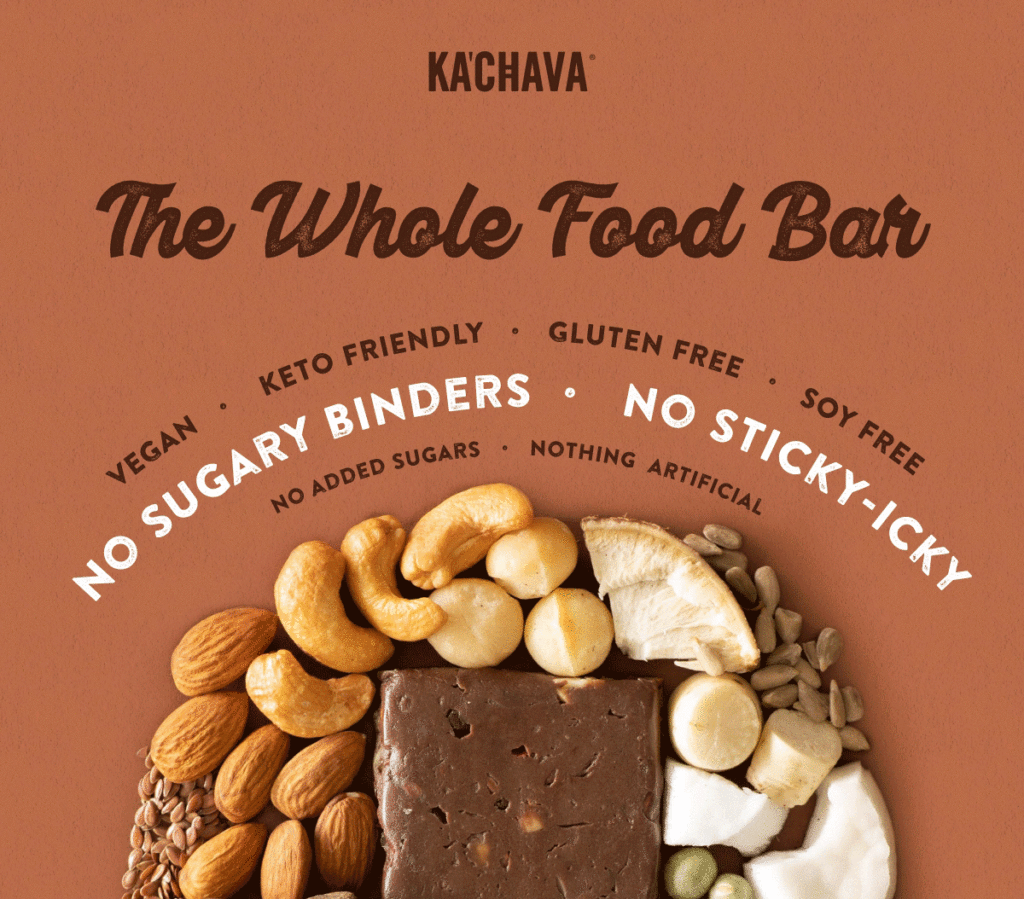Table of Contents
What Is A Ka’Chava Bar?
Ka’Chava energy bars are formulated without any added sugars or artificial sweeteners—instead, they contain monk fruit. Available in a Chocolate and Peanut Butter flavours, they have a soft, chewy texture and crunchy elements such as nuts, seeds, cacao nibs, and more.
Ka’Chava Bar Ingredients
Ka’Chava bars contain a high fibre content at 13g (46% of the daily recommended amount for an adult!) and are generally not too strenuous on your digestive system. The brand suggests eating one bar a day.
Below, we’ll break down the ingredients of Ka’Chava bars and their health benefits, so that you can see if they’re good for you.
Cashews:
Cashews are tree nuts that are high in healthy fats, protein, and minerals like magnesium, zinc, and copper. They have a creamy, slightly sweet taste and are commonly used in both sweet and savory dishes, as well as snacks.

Cassava Fiber:
Cassava fiber is derived from the cassava root, a starchy root vegetable. It is a type of resistant starch, which means that it is not digested in the small intestine but instead ferments in the large intestine, providing benefits to gut health.
Chicory Root:
Chicory root is a type of plant that is commonly used as a coffee substitute due to its similar taste and texture. It is also high in inulin, a type of fiber that can aid in digestion and promote gut health.
Pea Protein:
Pea protein is a plant-based protein derived from yellow peas. It is a good source of protein, low in fat, and easy to digest. Pea protein is often used as a vegan or vegetarian alternative to whey protein.
Cacao nibs
Cacao nibs are small pieces of crushed cocoa beans that are rich in antioxidants and flavonoids. They have a bitter, chocolatey taste and can be used in baking or added to smoothies and other dishes for a nutritional boost.
Pumpkin seeds:
Pumpkin Seeds: Pumpkin seeds are the edible seeds of pumpkins, high in protein, healthy fats, and minerals like magnesium and zinc. They have a nutty, slightly sweet flavor and can be eaten raw or roasted.
Sancha inchi
Sacha inchi is a plant native to South America that produces edible seeds. These seeds are high in protein, omega-3 fatty acids, and other nutrients. Sacha inchi seeds have a nutty flavor and are often used in smoothies, granolas, and other health foods.
Unsweetened chocolate:
Unsweetened chocolate also known as baking chocolate, is made from pure cocoa solids and has no added sugar. It has a bitter taste and is often used in baking and cooking.
Flax seeds:
Flax seeds are small, brown seeds that are high in fiber, omega-3 fatty acids, and other nutrients. They have a nutty flavor and can be added to baked goods, smoothies, and other dishes for a nutritional boost. Flax seeds can also be used to make flaxseed oil.
Coconut oil:
Coconut oil is a type of oil derived from the meat of coconuts. It is high in saturated fat but also contains medium-chain triglycerides, which can have potential health benefits such as improved brain function and weight loss. It is often used in cooking and baking.
Macadamia nuts:
Macadamia nuts are tree nuts that are high in healthy fats, protein, and fiber. They have a creamy, buttery taste and are commonly used in both sweet and savory dishes, as well as snacks.
Almonds:
Almonds are tree nuts that are high in protein, healthy fats, and minerals like magnesium and calcium. They have a mild, slightly sweet flavor and are commonly used in baking, as well as snacks.
Sea salt:
Sea salt is a type of salt that is produced by evaporating seawater. It contains trace minerals like magnesium and potassium and is often used to enhance the flavor of food.
Vanilla extract:
Vanilla extract is a flavoring made from vanilla beans. It is commonly used in baking and cooking to add a sweet, floral flavor to dishes.
Sunflower seed extract:
Sunflower seed extract is derived from sunflower seeds and is rich in antioxidants and polyphenols. It is often used in health supplements and functional foods for its potential health benefits.
Monk fruit extract
Monk fruit extract is a natural sweetener derived from the monk fruit. It is calorie-free and has a sweet taste, making it a popular alternative to sugar in foods and beverages.
References
Medically Cited: Our process involves examining medical research that has been published in reputable scientific journals, with the goal of upholding the highest possible standards of scientific accuracy.
Fact-Checked: To maintain quality, Repositive assigns a team of medical experts, including doctors and Registered Dietitians, to each article.
1. Cordeiro, T.A., A review on the nutritional aspects and health benefits of cashew (Anacardiumoccidentale). 2014, Al-Shodhana: A Multi-Disciplinary Refereed Research Journal. https://www.staloysius.edu.in
2. Montagnac, J.A., C.R. Davis, and S.A. Tanumihardjo, Nutritional value of cassava for use as a staple food and recent advances for improvement. Comprehensive Reviews in Food Science and Food Safety, 2009. 8(3): p. 181-194. https://ift.onlinelibrary.wiley.com
3. Nwafor, I.C., K. Shale, and M.C. Achilonu, Chemical composition and nutritive benefits of chicory (Cichorium intybus) as an ideal complementary and/or alternative livestock feed supplement. The Scientific World Journal, 2017. https://pubmed.ncbi.nlm.nih.gov/29387778/
4. Wang, J., et al., Recent advances in the health benefits of pea protein (Pisum sativum): bioactive peptides and the interaction with the gut microbiome. Current Opinion in Food Science, 2022. 48: p. 100944. https://www.sciencedirect.com/science
5. Vega, C. and C. Kwik-Uribe, Theobroma cacao—An introduction to the plant, its composition, uses, and health benefits, in Cocoa butter and related compounds. 2012, Elsevier. p. 35-62. https://www.sciencedirect.com/science
6. Syed, Q.A., M. Akram, and R. Shukat, Nutritional and therapeutic importance of the pumpkin seeds. Seed, 2019. 21(2): p. 15798-15803. https://biomedres.us
7. Goyal, A., et al., Sacha inchi (Plukenetia volubilis L.): An emerging source of nutrients, omega-3 fatty acid and phytochemicals. Food Chemistry, 2022. 373: p. 131459. https://www.sciencedirect.com/science
8. Zevnik, N., Chocolate goodness: Headlines trumpeting its health benefits have delighted the hearts of chocolate lovers everywhere. Better Nutrition, 2016. 78(2): p. 54-56. https://go.gale.com/ps/i.do
9. Langer, S., et al., Flavanols and methylxanthines in commercially available dark chocolate: A study of the correlation with nonfat cocoa solids. Journal of Agricultural and Food Chemistry, 2011. 59(15): p. 8435-8441. https://pubmed.ncbi.nlm.nih.gov/21699218/
10. Gutte, K.B., A. Sahoo, and R.C. Ranveer, Bioactive components of flaxseed and its health benefits. International Journal of Pharmaceutical Sciences Review and Research, 2015. 31(1): p. 42-51. https://globalresearchonline.net
11. Goyal, A., et al., Flax and flaxseed oil: An ancient medicine & modern functional food. Journal of Food Science and Technology, 2014. 51: p. 1633-1653. https://www.ncbi.nlm.nih.gov
12. Deen, A., et al., Chemical composition and health benefits of coconut oil: An overview. Journal of the Science of Food and Agriculture, 2021. 101(6): p. 2182-2193. https://onlinelibrary.wiley.com
13. Munro, I.A. and M.L. Garg, Nutrient composition and health beneficial effects of macadamia nuts, in Tree Nuts: Composition phytochemicals and health effects. 2008, CRC Press. p. 263-272. https://www.taylorfrancis.com
14. Barreca, D., et al., Almonds (Prunus dulcis Mill. DA webb): A source of nutrients and health-promoting compounds. Nutrients, 2020. 12(3): p. 672. https://pubmed.ncbi.nlm.nih.gov/32121549/
15. Galvis-Sánchez, A.C., et al., Sea salt, in Comprehensive Analytical Chemistry. 2013, Elsevier. p. 719-740. https://www.sciencedirect.com/science
16. Singletary, K.W., Vanilla: Potential health benefits. Nutrition Today, 2020. 55(4): p. 186-196. https://journals.lww.com/nutritiontodayonline
17. Petraru, A., F. Ursachi, and S. Amariei, Nutritional characteristics assessment of sunflower seeds, oil and cake. Perspective of using sunflower oilcakes as a functional ingredient. Plants, 2021. 10(11): p. 2487. https://www.mdpi.com/2223-7747/10/11/2487
18. Ban, Q., et al., Physiochemical, rheological, microstructural, and antioxidant properties of yogurt using monk fruit extract as a sweetener. Journal of Dairy Science, 2020. 103(11): p. 10006-10014. https://www.sciencedirect.com/science
Next, don’t forget to check out our complete breakdown of Ka’Chava Health Benefits.

Leave a Reply